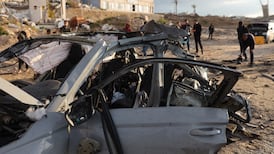Forty-one people have died in the week-long protests that have erupted in Iran after the death in detention of a young woman accused of failing to wear the hijab, according to state television.
The death toll – which the broadcaster said was “unofficial” – is higher than the figure confirmed by the authorities and state-affiliated news agencies, which reported at least 16 deaths, including nine members of the security forces, in the most violent unrest since 2019 protests over fuel prices.
Iran’s president Ebrahim Raisi, speaking by phone on Saturday to the family of one of the security personnel who was killed, dismissed the demonstrations as “rioting and wickedness” and said he urged the authorities to “decisively deal with those who disrupt the country’s security and peace”.
Amnesty International said there had been “a harrowing pattern of Iranian security forces deliberately and unlawfully firing live ammunition at protesters”.
READ MORE
The protests broke out across the country after a 22-year-old woman of Kurdish ethnicity, Mahsa Amini, died after being arrested by the morality police for allegedly violating the Islamic dress code for women.
[ The Irish Times view on protests in Iran: anger and courageOpens in new window ]
Many Iranians do not believe the official account of her death and claim she was beaten while in custody before falling into a coma and dying in hospital four days later. The authorities have denied the allegations and released CCTV footage showing Ms Amini walking into the police station.
They said medical examinations showed no fracture to her skull while her family doctor said surgery to her brain when she was eight could have made her vulnerable to stress. Her family insists she was healthy when she was taken into custody.
While protests continued across Iran on Saturday night, including in some parts of the capital, Tehran, they have become significantly smaller as the official crackdown intensifies.
The protests reached their peak on Wednesday night when, according to Amnesty, 19 people died in clashes between demonstrators and riot police.
Tasnim news agency, affiliated to Iran’s Revolutionary Guards, said at least 1,200 protesters had been arrested. Domestic media said journalists, political activists and university students were among those taken into custody.
After the Iranian authorities cut access to Instagram and WhatsApp in an effort to prevent co-ordination between protesters, the US treasury department announced on Friday that it would allow technology companies “to offer the Iranian people more options of secure, outside platforms and services”.
While some of the protesters have called for regime change, commentators do not believe the latest unrest poses a major threat to the government. “Iranians in general are not in that mood of regime change,” a reformist politician said.
But Iranians have been struck by the bravery of those who have taken to the streets, many of whom are women, either the same age as Ms Amini or even younger.
A teenage girl in the northern city of Babol was shown, in a video that went viral, standing on a platform in the street, refusing to wear her hijab. When confronted by the morality police she said: “I’m dressed properly” even though she was not wearing her scarf. Many women protesters burned their scarves and stood face to face with riot police without their hijabs.
“I’m in shock and awe when I see these young girls and boys not scared of anything, even bullets,” said Ali, a 45-year-old businessman. “It is a new reality the Islamic republic is facing.”
– Copyright The Financial Times Limited 2022














